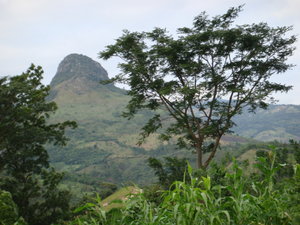Advertisement
Published: November 22nd 2008

 Scene from the bus
Scene from the bus
Close to Camotan, GuatemalaI left via bus Thursday morning to go to the little town of Copan Ruinas. I first took a bus to the 18th street in the Zone 1 of Guatemala City. This is the place were one finds all the bus lines to take you out and away from the capital city to the tourist spots.
The bus I chose was the one direct to Chiquimula. On this route, you leave Guatemala City from the east and eventually find yourself in the middle of the arid region of Zacapa. Here you see fron the roadside all sorts of cacti. It really is interesting. Zacapa and Chiquimula are cities that lie in the same Montagua river valley that continues eastward to the ruins of Copan.
The bus rides were interesting. The first, being a large Greyhound type, took approximately 4 hours to arrive in Chiquimula. Here in this town, I had lunch and then took a small minivan type of bus to the international border crossing of El Florido. The scenery of this journey is really nice.
Arriving at the border crossing, I paid my $3 entry tax to the Honduran immigration authorities and walked across the border. As

 My Favorite Food
My Favorite Food
This tree was growing in the courtyard of the Regional Museum of Copan.luck would have it, there was already a small minivan type bus to take me on to the town of Copan Ruinas. This ride was only 12 km.
Upon arriving in town, I set out to find a small hotel.
This small town with its cobblestone streets just 12km across the eastern border of Guatemala, is really a place to see. I imagine the economy here is based mainly on tourism as well as other cash crops such as bananas, coffee, and tobacco. Just a short walk from the little town, you will find the acient Mayan city of Copan. These mayan ruins are some of the best preserved in the Mayan world. The ruins have so much detail.
The Mayan kingdom of Copan was founded in approximately in 160 B.C. This was the time when the Mayan kings began writing in stone the actual dates of the events taking place. It is estimated that permanent settlements of people had been in the Copan river valley since 1000 B.C.
The first ruler of Copan was Yax-K'uk'-Mo which means either Green Quetzal Macaw or Great-Sun First. He came from the Peten region of northern Guatemala and set

 View from the Accropolis
View from the Accropolis
View of the ceremonial ballcourt.up a kingdom here in the river valley of Copan. His accession to the throne took place in 426 A.D.
Many of the ruins in the acropolis of Copan depict the thirteenth king, Waxaklahun-Ubah-K'awil or 18 Rabbit, one of the first being a stela that is dated, by using the Mayan dating system, 711 A.D.
This ruins are really impressive. There are temples, altars, stela, and a great hieroglyphic staircase.
This truly is an amazing place. The detailed glyphs carved on many of the bricks and stones, carved more than a thousand years ago, tell stories of these Pre-Colmbian people.
Advertisement
Tot: 0.077s; Tpl: 0.01s; cc: 6; qc: 45; dbt: 0.0555s; 1; m:domysql w:travelblog (10.17.0.13); sld: 1;
; mem: 1.1mb

 Scene from the bus
Scene from the bus
 My Favorite Food
My Favorite Food
 View from the Accropolis
View from the Accropolis


